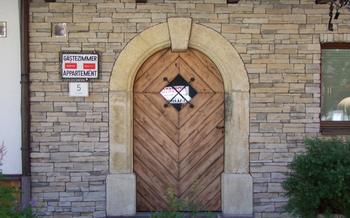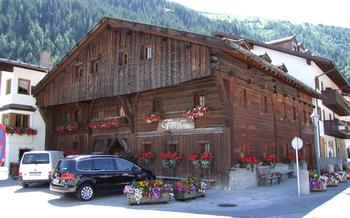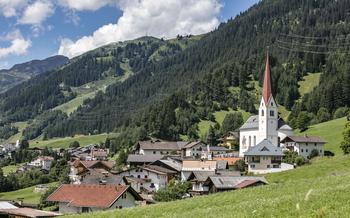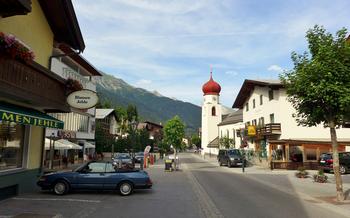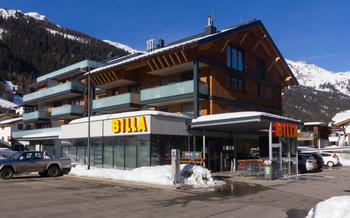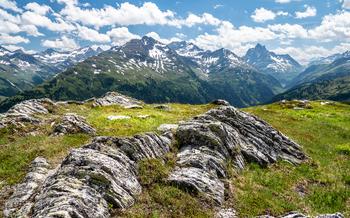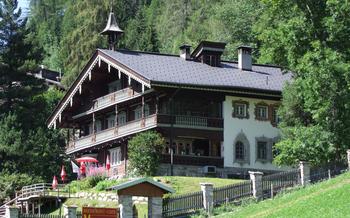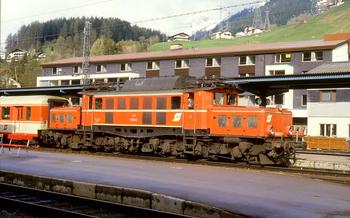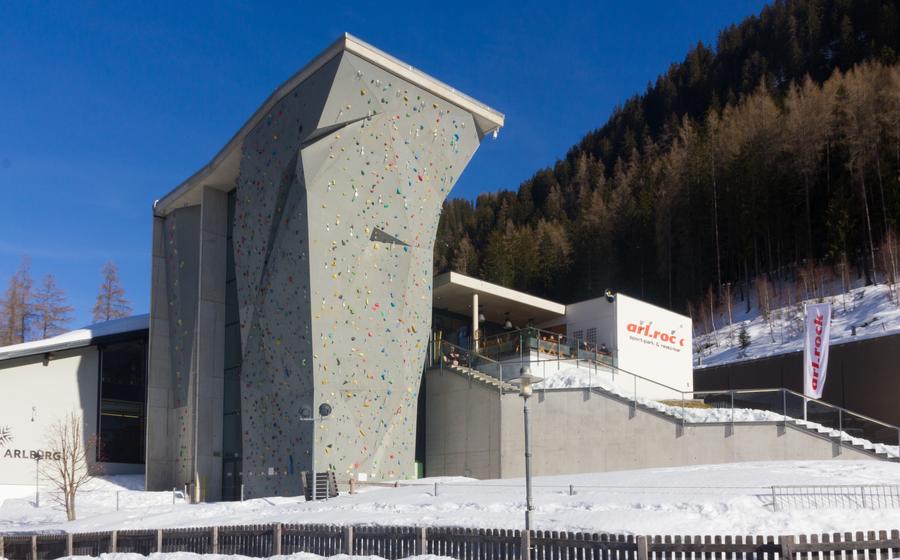
Arlberger Via Ferrata
- Atop the Arlberg Pass:
- Difficulty Levels:
- Preparation and Training:
- Booking a Guided Tour
- Best Time to Visit
- Getting There:
- Accommodation
- Food and Drink
- Other Activities in St. Anton
- Nearby Attractions
- Sustainable Tourism
- Insider Tip:
Atop the Arlberg Pass:
St. Anton am Arlberg, a picturesque village perched atop the Arlberg Pass in Austria's westernmost state of Tyrol, has long been a haven for adventurers and nature enthusiasts. The history of the pass is intertwined with trade and travel, as it served as a crucial link between the Roman Empire and the Germanic tribes during ancient times. Its strategic importance continued throughout the Middle Ages, when it became a vital trade route connecting Northern Europe with the Mediterranean.
The Arlberg Pass is renowned for its breathtaking scenery, with towering peaks, lush valleys, and sparkling lakes painting a picture of alpine splendor. Its proximity to popular destinations such as Innsbruck, Zurich, and Munich makes it an ideal base for exploring the region. Whether you're an avid skier, a passionate hiker, or simply seeking a tranquil escape amidst nature's wonders, St. Anton has something to offer every traveler.
Difficulty Levels:
The Arlberger Via Ferrata is divided into different sections, each with its own difficulty level. The difficulty rating system typically ranges from A to E, with A being the easiest and E being the most challenging.
-
A (Easy): Suitable for beginners with no prior via ferrata experience. The terrain is relatively flat with minimal exposure and technical challenges.
-
B (Moderate): Requires some basic climbing skills and a good level of fitness. The route may involve steeper sections, minor obstacles, and some exposure.
-
C (Difficult): Suitable for experienced climbers with good technical skills and endurance. The terrain becomes more challenging, with steeper climbs, larger obstacles, and greater exposure.
-
D (Very Difficult): Only for highly experienced climbers with excellent technical skills and physical fitness. The route involves extremely steep sections, significant exposure, and complex obstacles.
-
E (Extremely Difficult): Reserved for professional climbers with exceptional skills and experience. The terrain is extremely challenging, with vertical walls, overhanging sections, and highly exposed passages.
Before embarking on the Arlberger Via Ferrata, it's crucial to assess your skill level and choose a section that matches your abilities. If you're unsure about your level, consider hiring a professional guide who can help you select an appropriate route and ensure your safety throughout the climb.
Preparation and Training:
Preparation is paramount for a successful and enjoyable via ferrata experience. Prioritize building upper body strength and endurance with exercises like pull-ups, rock climbing, or weight training. Improve your cardiovascular fitness through activities like running, cycling, or swimming.
Pack appropriately for the adventure. Wear comfortable, breathable clothing that allows for freedom of movement. Sturdy hiking boots with good ankle support are essential. Don't forget to bring a helmet, gloves, and sunglasses for protection.
Acclimatizing to the altitude is crucial, especially if you're coming from a lower elevation. Spend a few days gradually ascending to higher altitudes before attempting the via ferrata. This helps your body adjust to the thinner air and reduces the risk of altitude sickness.
Booking a Guided Tour
Hiring a professional guide for your Arlberger Via Ferrata adventure offers several advantages. Experienced guides have an intimate knowledge of the route, can provide expert instruction, and ensure your safety throughout the climb. They carry additional safety equipment, such as ropes and communication devices, and are trained to handle emergencies. By booking a guided tour, you can relax, focus on the experience, and learn from the expertise of your guide.
To choose a reputable guiding company, research online, read reviews, and ask for recommendations from friends or fellow climbers. Look for companies that are certified by the Austrian Alpine Association or have a proven track record of safety and professionalism. Inquire about their experience, qualifications, and safety protocols. A good guiding company will provide a comprehensive briefing, conduct a thorough safety check, and adapt the tour to your individual needs and abilities.
Guided via ferrata tours typically include equipment rental, instruction, and guidance throughout the climb. Prices vary depending on the length and difficulty of the route, the size of the group, and the guiding company. Booking in advance is recommended, especially during peak season, to secure your spot and avoid disappointment.
Best Time to Visit
The timing of your visit to the Arlberger Via Ferrata can significantly impact your experience. For optimal conditions, aim for the late spring, summer, or early fall months. During this period, the weather is generally stable, with warm and sunny days and cool nights. The trails are also less crowded, allowing you to fully immerse yourself in the stunning scenery without feeling rushed.
The peak season for via ferrata in St. Anton am Arlberg runs from July to August. While the weather is usually at its best during this time, it also attracts the most visitors. If you prefer a quieter experience, consider visiting in the shoulder seasons of June or September, when the weather is still pleasant, but the crowds are smaller.
Regardless of when you choose to visit, be prepared for unpredictable mountain weather. Always check the forecast before embarking on your climb and pack layers of clothing to accommodate changing conditions. By planning accordingly, you can ensure a safe and enjoyable via ferrata adventure in St. Anton am Arlberg.
Getting There:
Reaching St. Anton am Arlberg is a breeze, with a range of transportation options to suit every traveler. If you're arriving by car, the scenic Arlberg Pass road (B197) will lead you directly to the heart of the village. Ample parking is available in St. Anton, with both paid and free options. The St. Anton am Arlberg train station offers convenient connections to major cities in Austria and beyond, making it an excellent choice for those traveling by rail. Once in St. Anton, the starting point for the Arlberger Via Ferrata is easily accessible on foot or by taking the local bus. Detailed directions and timetables are available at the St. Anton Tourismus information office.
Accommodation
St. Anton am Arlberg offers a wide range of accommodation options to suit every budget and preference. From luxurious hotels with world-class amenities to cozy guesthouses with a charming atmosphere, there's something for everyone in this vibrant Alpine town.
If you're looking for a truly unforgettable experience, consider splurging on a stay at one of the five-star hotels in St. Anton. These properties offer breathtaking views of the surrounding mountains, Michelin-starred restaurants, and state-of-the-art wellness facilities.
For those seeking a more budget-friendly option, there are numerous guesthouses and bed and breakfasts that offer comfortable rooms at affordable prices. Many of these establishments are family-run and provide a warm and welcoming atmosphere.
No matter your budget, it's essential to book your accommodation in advance, especially during the peak season. St. Anton is a popular destination for skiers and snowboarders in the winter and hikers and mountain bikers in the summer.
Here are a few insider tips for securing the best deals on accommodation in St. Anton:
- Consider staying in a neighboring village, such as St. Christoph or Lech, where prices tend to be lower.
- Book your accommodation well in advance, especially if you're traveling during the peak season.
- Look for discounts and special offers on websites such as Booking.com and Expedia.
- Consider staying in a hostel or dormitory if you're on a tight budget.
- Ask about group discounts if you're traveling with friends or family.
Food and Drink
St. Anton am Arlberg offers a diverse culinary scene that caters to every palate. From traditional Austrian dishes to international cuisine, there are plenty of options to satisfy your cravings. Start your day with a hearty breakfast at one of the many bakeries or cafes in town. Try the local specialty, "Kiachl," a type of fried dough served with jam or powdered sugar. For lunch, indulge in a classic Tyrolean dish such as "Käsespätzle" (cheese spaetzle) or "Tiroler Gröstl" (fried potatoes with meat and onions). Dinnertime is a great opportunity to sample some of the region's renowned wines. Pair your meal with a glass of Zweigelt or Grüner Veltliner, two popular Austrian grape varieties. Be sure to try "Kaiserschmarrn" for dessert, a fluffy pancake served with powdered sugar and fruit compote. For a unique dining experience, head to one of the mountain huts in the area. These rustic restaurants offer panoramic views of the Alps and serve traditional Austrian dishes made with fresh, local ingredients. Whether you're looking for a quick bite or a leisurely meal, St. Anton am Arlberg has something for everyone.
Other Activities in St. Anton
While the Arlberger Via Ferrata is undoubtedly a top attraction in St. Anton am Arlberg, the town offers a plethora of other activities to suit every taste and preference. Whether you're seeking adrenaline-pumping adventures or leisurely pursuits, St. Anton has something for you.
In the summer, the surrounding mountains beckon hikers and mountain bikers with an extensive network of well-marked trails. Explore the scenic valleys, climb to breathtaking viewpoints, and immerse yourself in the tranquility of the alpine wilderness.
During the winter months, St. Anton transforms into a winter sports paradise. With its world-class ski slopes, cross-country trails, and snowshoe routes, it's a haven for skiers, snowboarders, and winter enthusiasts of all levels.
Beyond its outdoor offerings, St. Anton is also a vibrant cultural hub. Take a stroll through the charming town center and admire the traditional Tyrolean architecture. Visit the local museum to learn about the region's rich history and heritage. Participate in traditional festivals and events to experience the lively Alpine culture firsthand.
Whether you're a seasoned adventurer or a casual traveler seeking relaxation, St. Anton am Arlberg has something for everyone. Embrace the diverse experiences this charming town offers and create memories that will last a lifetime.
Nearby Attractions
St. Anton is a gateway to a wealth of attractions beyond the Arlberger Via Ferrata. Take a scenic day trip to the charming villages of Lech, Zürs, and St. Christoph, each offering its unique charm and breathtaking Alpine vistas. Explore the Tyrolean State Museum in Innsbruck, showcasing the region's rich history and culture. For more via ferrata adventures, venture to the nearby Valluga Nordwand in Lech or the Schrofenstein in Kühtai. Hike the scenic Lechweg trail, offering stunning mountain panoramas and pristine alpine lakes. Discover the Tyrolean Zugspitze, Austria's highest peak, and marvel at its breathtaking glacier views. With so much to see and do, St. Anton serves as an ideal base for crafting a customized itinerary that caters to your interests and time constraints.
Sustainable Tourism
As a traveler, it's our responsibility to minimize our impact on the environment and support the communities we visit. When embarking on a via ferrata adventure in St. Anton, consider the following sustainable practices:
- Reduce your carbon footprint: Opt for public transportation or carpooling to reach the starting point.
- Choose local guides and businesses: Support the local economy by hiring certified guides from St. Anton and purchasing souvenirs from local artisans.
- Respect the flora and fauna: Stay on designated trails, avoid disturbing wildlife, and leave no trace of your passage.
- Dispose of waste responsibly: Carry a reusable water bottle and dispose of trash properly in designated bins.
- Educate yourself about local customs: Familiarize yourself with Austrian traditions and customs to ensure you act respectfully.
By embracing sustainable tourism, we can preserve the pristine beauty of St. Anton and ensure that future generations can enjoy the same breathtaking experiences.
Insider Tip:
Venture beyond the main tourist trail to discover the secret spots that offer breathtaking views of the Arlberg region. Hike to the top of Valluga, the highest peak in the area, for a panoramic vista that will leave you speechless. For a hidden gem off the beaten path, explore the idyllic hamlet of St. Christoph, nestled in a tranquil valley surrounded by towering mountains. Immerse yourself in local customs and traditions by attending a traditional Austrian folk festival, where you can experience the vibrant music, dance, and cuisine of the region. Bring home a unique souvenir to cherish your memories, such as a handcrafted Tyrolean hat or a bottle of locally produced schnapps.


